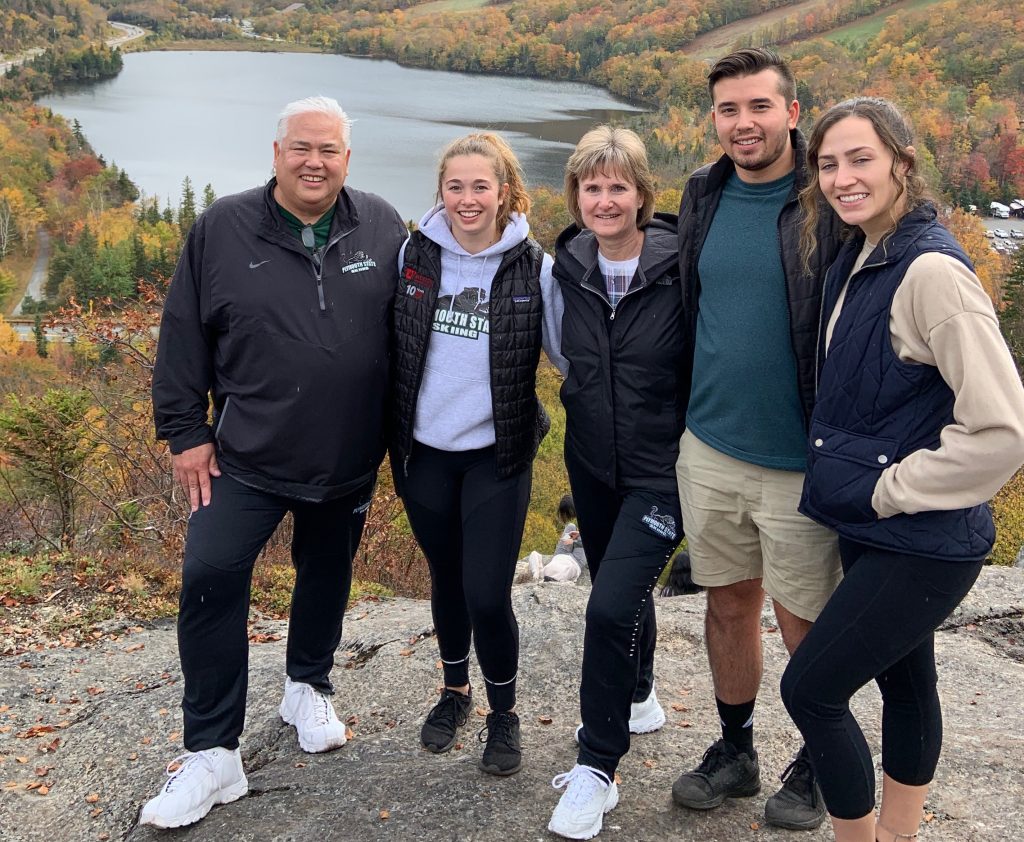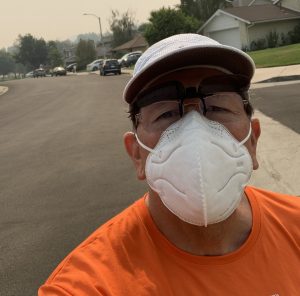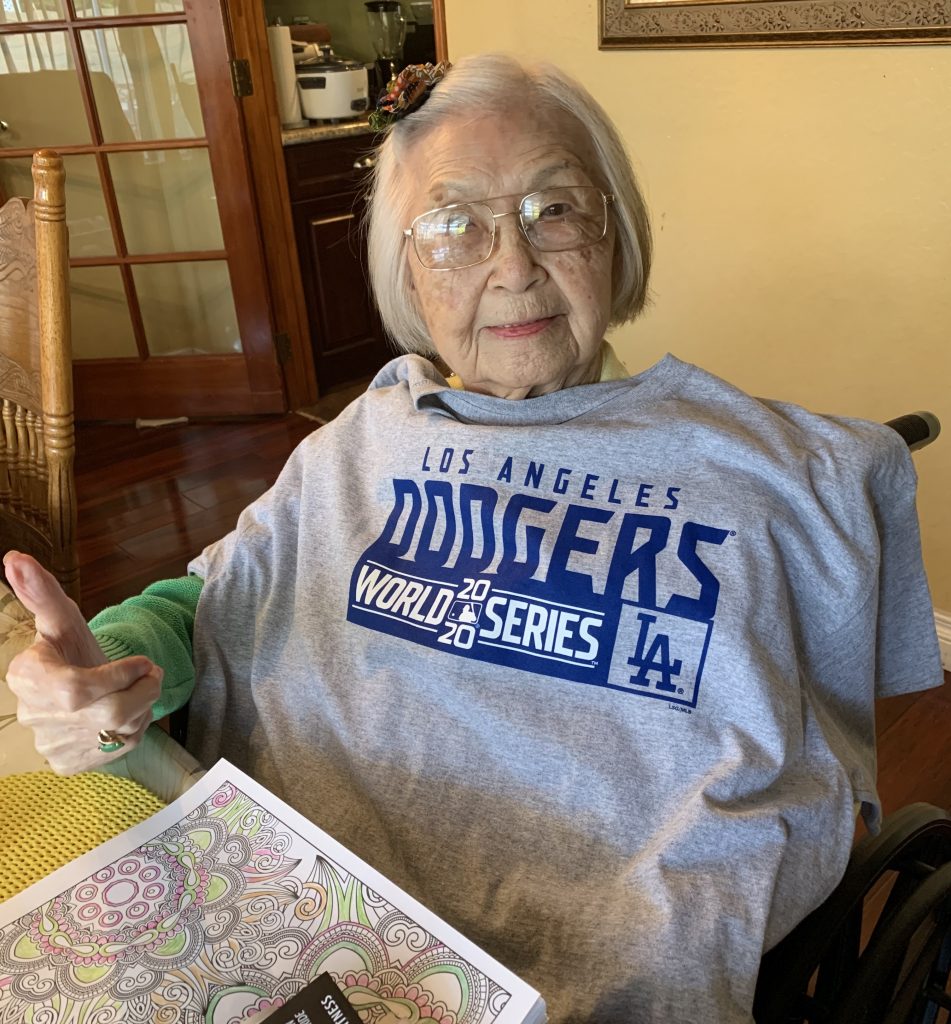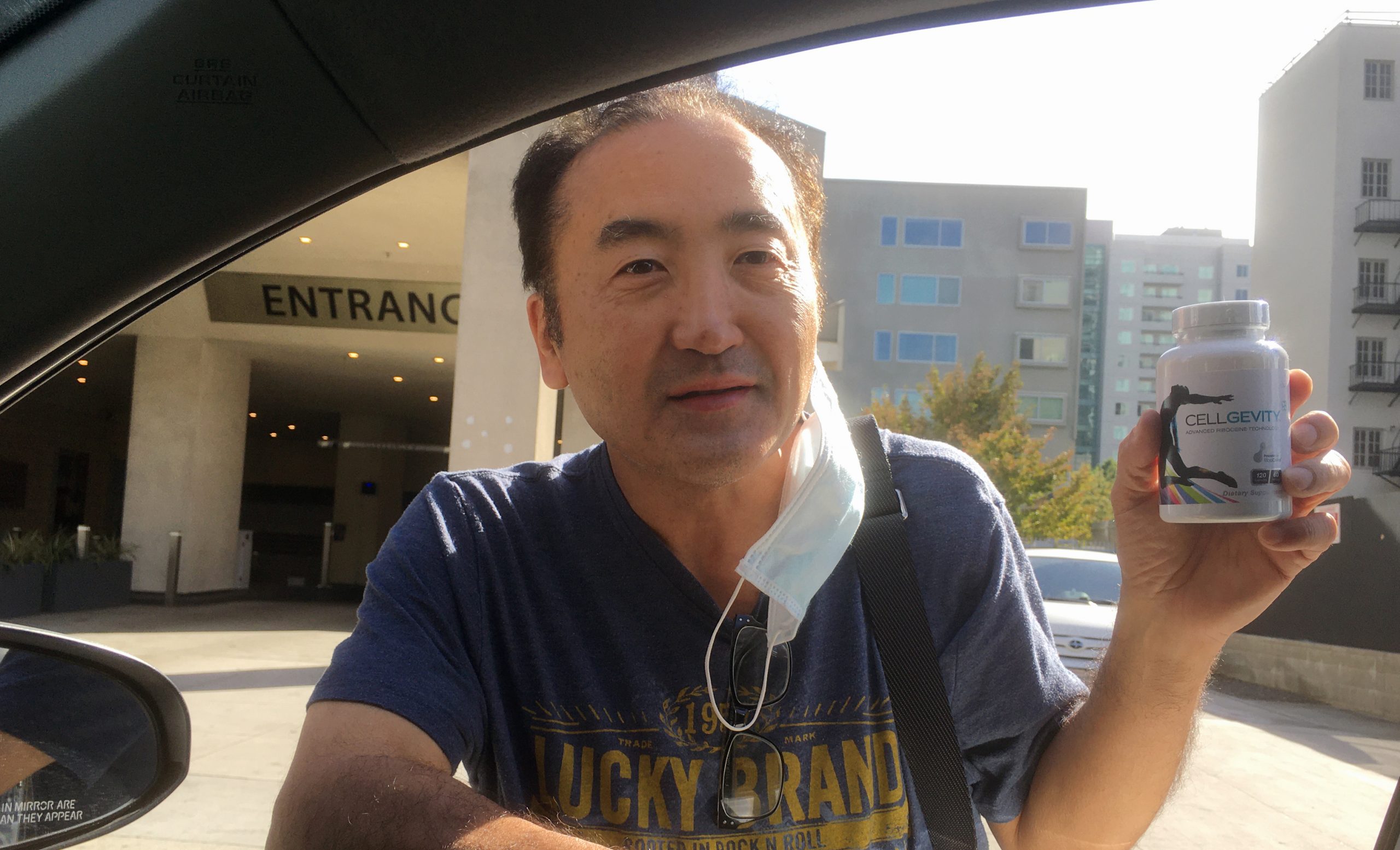Yosh Nakano, who has for more than 10 years been an advocate for boosting one’s immune system via glutathione enhancement with the dietary supplement Cellgevity, had his beliefs put to the test this past spring when he fell ill with Covid-19. (Photo: George Toshio Johnston)
Townsend, Nakano and Dorio: Following up on the ‘Year of Living Dangerously’
By George Toshio Johnston, Senior Editor, Digital & Social Media
(Editor’s Note: In the May 8-21, 2020, issue, the Pacific Citizen published three articles related to the novel coronavirus.
One was on Yosh Nakano, a professional poker player who has become an evangelist for the benefits of enhancing the body’s natural production of master antioxidant and immune-system booster glutathione, via Cellgevity and MaxOne, proprietary nutritional supplements developed by Dr. Herbert Nagasawa (see tinyurl.com/ycsm5ow5).
Another was on Chuck Townsend of Layton, Utah, who developed Covid-19 and spent several days in March hospitalized in an intensive care unit, on a ventilator (see tinyurl.com/yxwz4xm4).
And another article was about the challenges facing Dr. Gene Uzawa Dorio, a geriatric medicine specialist in Los Angeles County’s Santa Clarita Valley, who has a clientele of elderly patients — the group most at-risk of dying of Covid-19 (see tinyurl.com/y2gdrfgv).
The following article is an update about where the United States is at now under the pandemic — and the status quo of Nakano, Townsend and Dorio.)
The Dec. 8 news release from the Los Angeles County Department of Public Health was grim. The 2020 tally of confirmed Covid-19 deaths had reached 8,000. And, amid the latest surge of SARS-CoV-2 infections, 3,113 people were in area hospitals as they battled the novel coronavirus.
Statewide, according to the Dec. 9 Los Angeles Times, California had 1,421,783 confirmed cases and 20,273 deaths caused by the virus.
Nationwide, according to the Dec. 9 Washington Post, the count for coronavirus deaths was 287,000, with approximately 15,286,000 reported cases. The figures for November counted more than 1,500 Covid-19 deaths per day. In December, a new record was set: more than 3,000 Covid-19-related deaths in a single day.
To describe the effects of the virus on America’s people, economy, education system, health-care system and quotidian way of life, the word “disaster” is highly apropos — and grossly inadequate. It has affected everyone directly or indirectly, whether it was a hospital stay or death in the family, a lost job and/or home or, for the more fortunate, the inconvenience caused by the cancellation of myriad events planned months in advance.
Although there were some who contracted the virus and were asymptomatic, for those who contracted it and fell ill, some required hospitalization — and for some in that group, that meant being placed for several days in quarantined intensive care units while undergoing the unpleasant experience of being hooked up to machines that forced air into damaged lungs.
Some of those patients lived and recovered, thanks in part to doctors and nurses who learned from the early days of the outbreak the best methods of treatment, whether it was administering the steroid dexamethasone to aid in recovery or placing patients on their bellies instead of on their backs.
Nevertheless, many, too many, died. Some of those people had underlying conditions, like diabetes, that hurt their chances for survival. Some were overweight, another strike against them. More men died than women. The majority with “negative outcomes” were elderly.
Then there were the “long haulers”: those who fell ill and recovered, only to continue to have almost inexplicable long-term aftereffects, such as extreme fatigue, brain fog, fevers, the loss of sense of smell and taste, a lingering cough, joint pain and body aches.
Whether the long haulers grappling with those conditions weeks and months after beating Covid-19 only to deal with those sometimes-debilitating conditions will someday recover fully is unknown, as is why they suffer so.
Also concerning was — is? — the spike in incidents of anti-Asian violence. The dearth of leadership in the federal government’s executive branch to speak out forcefully against such anti-social behavior was just one of many “failures of political leadership” (Where have we heard that phrase before?), including urging effective preventative measures such as physical distancing and mask-wearing, concealing and downplaying the highly contagious nature of the airborne bug or setting examples by curtailing large gatherings.
The pandemic has been like the draught that exposed beneath a lake a ghost town of crumbled social and physical infrastructure and political fissures once hidden by placid waters, cognitive dissonance, irrational defiance and magical thinking.
Now, in late 2020, the United States is facing a surge of cases, especially in parts of the country that did not experience the early wave of the virus’ spread. Experts say holiday gatherings and cold weather that drives people indoors will exacerbate an already dire status quo.
There are also, however, hopeful signs. Vaccines developed amazingly quickly from Pfizer-BioNTech, Moderna and AstraZeneca with success rates of more than 90 percent have been or will be approved, with another vaccine on the way from Johnson & Johnson that supposedly does not require extreme cold or multiple inoculations.
If these vaccines actually work as hoped, a year from today might see the worst of the pandemic as being months in the past, though with a years-long recovery necessary. That means a Herculean national effort to distribute vaccines to millions over the coming months. Short-term, the mantras of “mask up” and “hunker in your bunker” are still the order of the day.
It’s also an opportunity to re-evaluate and reset the “business as usual” mentality, address and repair those fissures and rotting structures — and prepare for the next pandemic.
❖❖❖
As a professional poker player, Yosh Nakano has had to become adept at calculating the probabilities of winning and losing at cards.
He has applied that mindset to his own health. How? By increasing the odds of staying well by bolstering his immune system. You could even say Nakano has literally bet his life on it.
After the Pacific Citizen’s May 8 article on Nakano and his mission to evangelize the benefits of increasing the body’s production of GSH (glutathione) via proprietary dietary supplements, he himself became infected with the novel coronavirus — and he lived to tell the tale.
Back in late May, Nakano believes he contracted the virus by playing in what he called the private home circuit. “Poker games never really shut down,” he said, even as restaurants, bars, gyms and nail and hair salons were forced to close or change their business models.
“I’m a diabetic, and 50 percent of all Covid-19 deaths are diabetics,” according to Nakano. He’s also in his mid-60s and is a male. “But I knew I had Cellgevity on my side.”
Cellgevity, along with MaxOne, are dietary supplements that increase the body’s ability to naturally produce GSH, which is known as endogenous production. The two products contain RiboCeine, a proprietary molecule developed by Dr. Herbert Nagasawa.
As noted in May, “Nagasawa’s research determined that ribose — a simple sugar — combined with cysteine worked the best at helping the body produce GSH.” He patented the molecule, which he dubbed RiboCeine, which is “ … uniquely able to deliver cysteine into the body’s cells, which then allow the effective production of GSH.”
Nakano recalls that it was on Tuesday, May 26, that he began to feel flu-like symptoms: muscle aches and chills. “So, I was thinking, ‘Boy, I wonder if this is Covid-19,’” Nakano said. It was the first time he said he had felt ill in the more than 10 years since he began taking Cellgevity on a regular basis. “I just spent the night in bed and woke up the next day fine.”
Nevertheless, he realized that he got tired easily, which told him something was wrong. He was tested on the following Thursday — and on Sunday, May 31, he got the results back: positive for Covid-19.
With that result, Nakano decided to self-quarantine for nine more days. During that time, he slept a lot, watched TV, worked on his website — but other than a decreased appetite, he didn’t have much in the way of severe symptoms, though food tasted saltier than normal. “The doctors said that was a very unusual symptom,” he said.
He was retested and the result came back positive again. “Then I got two calls. First, I got a follow-up from the L.A. County Health Dept. She gave me a number, and I talked to a doctor there, and the doctor said the virus will stay in your system, sometimes for weeks, but you’re no longer contagious,” Nakano said. “You’re getting a positive result because the dead virus can stay in your system.
“Thirty minutes later,” he continued, “I got another call, this time from a doctor directly from the L.A. County Health Dept., and he told me the same thing.”
That wasn’t the only good news for Nakano. With the rapid spread of the virus, he says his side business selling Cellgevity and MaxOne via his website, MagicalGSH.com, has increased significantly. More good news: He got an antibody test and was given the results. “I do have the antibodies,” he said.
“Even if your antibodies should dissipate, you still have these Memory B cells in your immune system that will recognize the virus for decades and immediately produce antibodies.”
For Nakano, another side benefit is the relief of the stress from worrying about contracting the coronavirus. As for any of the symptoms experienced by the long haulers, he said he is free of any of that, too.
Asked why there has been no news coverage — with the exception of what appeared in the Pacific Citizen — regarding the beneficial effects of boosting one’s immune system through GSH enhancement, Nakano says the primary problem is that as dietary supplements, Cellgevity and MaxOne do not require FDA approval. For a physician, who has been trained to prescribe drugs that have been tested and approved, a product like Cellgevity isn’t on the radar screen.
One exception Nakano cited is Dr. Douglas Harrington, who is a specialist in pathology and hematology and a proponent of glutathione enhancement. Nakano also cites a PubMed article that appeared in May shortly after his encounter with the coronavirus.
That study, titled “Endogenous Deficiency of Glutathione as the Most Likely Cause of Serious Manifestations and Death in Covid-19 Patients,” can be found at at tinyurl.com/y5ulwmqg. For Nakano, who knows he is not a doctor and that FDA compliance limits what he can say about the products he sells, he simply says that Cellgevity and MaxOne are the best products available for endogenous glutathione enhancement, which is vital for enhancing one’s immune system — and that it’s up to each person to do his or her own research and arrive at his or her own conclusions.
❖❖❖
For Chuck Townsend, the travel aspect of his job as a senior solutions architect for telecommunications systems integrator Tyto Athene is not just back to normal — it’s better than it ever was.
Since recovering from Covid-19, which put him into an ICU for almost two weeks in March, not only has his stamina and appetite returned, Townsend says the travel schedule that put him on airplanes nearly every other week has also returned, but with one major difference: airports and airliners have far fewer people. It’s not good for air carriers — but for frequent flyers like Townsend, not only is air travel much nicer, but he also has even been upgraded to first class several times.
As for sanitary conditions aboard the jets, Townsend said, “They’re spraying the cabins between flights and disinfecting all of the surfaces,” noting that the ventilation systems have HEPA filters so that the air quality is “ … in theory, better than in the airport and in general.” Mask-wearing, meantime, is mandatory.

Chuck Townsend, left, with daughter, Katie, wife, Lori, son, Michael, and his girlfriend, Grace Page. Townsend battled Covid-19 in March, spending nearly two weeks in an ICU. He has since recovered, but has lingering neuropathy in his left hand. (Photo: Courtesy of Lori and Charles Townsend)
Utah has, however, experienced an uptick in Covid-19 cases since “the pioneer days” of the outbreak that put Townsend into the hospital. His wife, Lori Townsend, said local hospitals have not, fortunately, been overwhelmed like in some parts of the nation. As a nurse, she knows firsthand the real issue: “The issue we’re having is not enough ICU nurses,” she said.
“The other issue is that once you have a Covid patient in the hospital, it’s kind of an automatic three- to four-week stay. They’re not in and out. The reason we get short on nurses is that it’s not a short stay when there’s a Covid patient.”
Add to that the fact that even though Lori is a registered nurse, being an ICU nurse takes additional training — and “you can’t just grow ICU nurses on a tree,” she said. Furthermore, some Covid patients, she noted, need to be put on ECMO (extracorporeal membrane oxygenation) machines to oxygenate their blood, and a nurse needs to be certified to operate an ECMO, and those machines are also in demand by heart patients.
As for Chuck and Covid-19, which at one point had Lori thinking he was going to die, his recovery has been remarkable — and he hasn’t suffered any severe aftereffects that have debilitated some long haulers.
“I still have neuropathy in one and a quarter fingers,” Townsend said of his left hand. “My pinkie feels swollen all the time and tingly. It’s much harder to use my left hand because it’s hard to squeeze my hand tight without it hurting. But it’s better than the last time we talked, when I had four fingers — two on my right hand, two on my left hand. I think my right hand is totally recovered, and my left hand is nearly 50 percent better.”
He isn’t even sure if the neuropathy is Covid-related, since his arms had to be strapped down while he was hospitalized so he wouldn’t unconsciously remove his breathing tube — which he strained his body to attempt. “I do remember fighting that ventilator quite a bit,” Townsend said.
As for lifestyle changes since recovering, Townsend said he is walking more and taking vitamins C, D and zinc supplements.
He has, however, heard from a couple of friends who have friends who had Covid-19 and are now long haulers. “They were very athletic and young, and they’re just falling apart, apparently, in general. I guess I am lucky compared with what I’m hearing from a couple people,” Townsend said.
❖❖❖
In the intervening months since he spoke to the Pacific Citizen, there have been a few changes for Dr. Gene Uzawa Dorio and his medical practice treating elderly patients in the Santa Clarita Valley.
For example, five of his patients actually contracted the novel coronavirus. Fortunately, all recovered, and only one required hospitalization — and her hospital stay did not involve getting treated in an ICU. “They all have flourished, and they’re all alive right now,” said Dorio.

Dr. Gene Uzawa Dorio practices what he preaches by wearing a mask when out in public. (Photo: Courtesy of Gene Dorio)
From his vantage point, activity within his practice has slowed down, and Dorio is not the only physician in that regard. He says people in general are not visiting doctors for fear of contracting the virus while seated in the waiting room — or even from the physician.
“I do advise them that I have Covid patients, and I have to be careful. Of course, they have to [be careful] also,” said Dorio.
One of his concerns: bedridden patients who are not getting visited by anyone.
“No one is going out to see them, other than myself during house calls,” said Dorio. “So, I stay in touch with them the best I can.”
The reimbursements are not much, he says, and for Medi-Cal patients, there is no reimbursement. “But that’s OK. I just call them up and make sure they’re doing OK and talk to the family or them. That’s my duty,” he said.
To help him keep tabs on his patients, Dorio has tried to make sure they have their own blood pressure cuffs and pulse oximeters, so they can check their own readings to share with him.
Something that hasn’t changed: wearing the personal protective gear when seeing patients, as well as his mother, Violet, who just celebrated her 99th birthday. An early birthday present came when the Los Angeles Dodgers won the World Series. She was elated when that happened.

Gene Dorio’s mother, Violet, gets regular visits from her son, Gene, and his brother and fellow physician, who both take safety precautions when visiting her. (Photo: Courtesy of Gene Dorio)
“She’s doing great,” he said. No longer limited to only seeing her via FaceTime, Dorio and one of his brothers, who lives nearby, visit often. For Dorio, he just makes sure that his visits coincide with days when he doesn’t see any patients in person.
Over the past six months or so, Dorio says the medical profession has learned how to deal with patients who get Covid-19. In addition to delaying the use of a ventilator until there is no choice, another treatment is “proning” patients (placing them on their bellies). Administering dexamethasone, he says is another treatment, as is using monoclonal antibodies, which he says was given to President Donald Trump and Housing and Urban Development Sec. Ben Carson.
Some of his fellow physicians also speculate that they received convalescent plasma, which contain antibodies for Covid-19. “It’s a learning curve,” Dorio said. “Less people are dying, but we think that may be an age factor. We don’t know.”
Asked if there is an answer why he thinks the nation overall is experiencing this third surge in the infection rate — despite everyone presumably having gotten the message to physically distance, avoid social gatherings and wear masks in public, Dorio said, “I think history will give us an answer.
“And, that history will tell us that the leadership of this country degraded the institution of medicine and science. By doing that, it allowed some to be disbelievers, that there was no problem. … Some were saying it was a hoax,” he continued. “I, of course, refute that. It is not a hoax. Some said that after the election, it would all disappear. Of course, it is now even worse. Leadership played a role.”
Come Jan. 20, however, there will be a change of leadership — and Dorio is confident that that, plus the advancement of medical science, gives hope for the future.
“I think you’ll probably have to do a follow up in six months or eight months again with us to see where are we at this point in our thought processes because I think it’s going to have changed in some way. It’s kind of the light at the end of the tunnel now. We were unsure in the very early part of this year, but now we can sense, with the vaccines, a turning of that corner,” Dorio said.
In a few months, Dorio said we’ll want to know, “How is medicine looking at this? How is Yosh doing at winning at poker? Has Charles’ neuropathy gone away? This is kind of like a diary of all the things that have happened.
“It’s interesting. It’s historic. It’s a lesson for us, our kids and science,” he concluded. “In the long run, though, the sad thing is that a quarter of a million people have died from this.”




